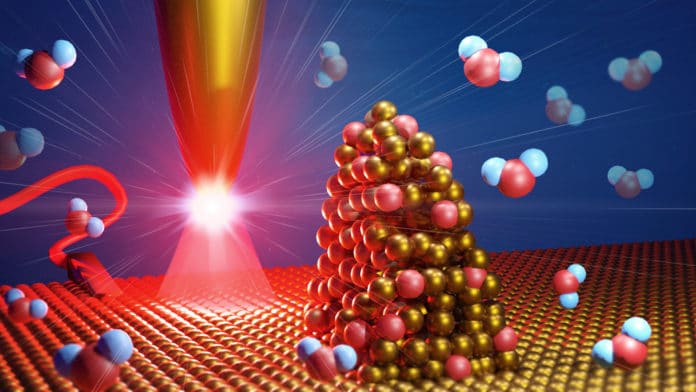Electrocatalysts often show increased conversion at nanoscale chemical or topographic surface inhomogeneities, resulting in spatially heterogeneous reactivity. Identifying reacting species locally with nanometer precision during chemical conversion is one of the biggest quests in electrochemical surface science to advance (electro)catalysis and related fields.
In a new study, scientists demonstrated a new method with which the initial steps electrocatalytic water splitting on a gold surface could be studied with a spatial resolution of less than 10 nm under operating conditions.
Scientists combined different methods of Raman technique with scanning tunneling microscopy. They scanned a nanometer-thin gold tip illuminated with laser light over the surface under investigation. Doing so, they amplified Raman signal by many orders of magnitude directly at the tip apex that acts as an antenna.
This strong enhancement effect enables the investigation of very few molecules at a time. Furthermore, the tight focusing of the light by the tip leads to a spatial optical resolution of fewer than ten nanometers.
Dr. Katrin Domke, independent Boehringer Ingelheim “Plus 3” group leader at the MPI-P said, “We were able to show experimentally that surfaces with protrusions in the nanometer range split water in a more energy-efficient way than flat surfaces. With our images, we can follow the catalytic activity of the reactive centers during the initial steps of water splitting.”
“We were able to show that during water splitting at nanometer rough spots – i.e., reactive centers – two different gold oxides are formed, which could represent important intermediates in the separation of the oxygen atom from the hydrogen atoms.”
With their investigations, it is now possible to gain more precise insight into the processes taking place on the nanometer scale on reactive surfaces and facilitate the design of more efficient electrocatalysts in the future, where less energy is needed to split water into hydrogen and oxygen.
The scientists have published their results in the renowned journal “Nature Communications.“
Reactivity mapping of nanoscale defect chemistry under electrochemical reaction conditions, Nature communications (2019). DOI: 10.1038/s41467-019-13692-3
